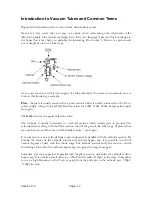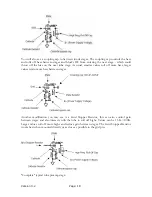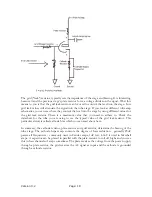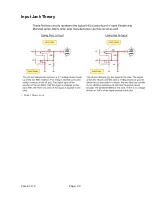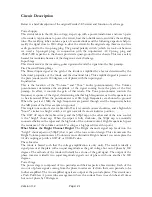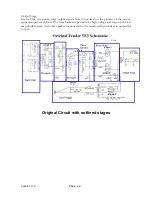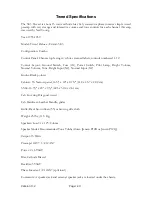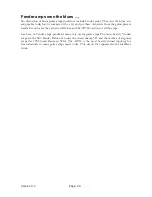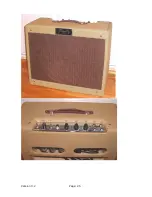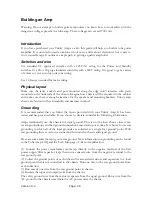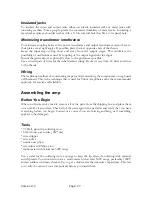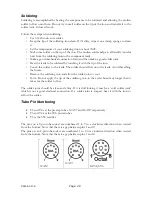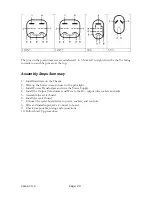
Version 3.2
Page: 14
So, each of the Tweed volume controls affects your tone to a noticeable degree by creating a
hidden voicing control allowing the player to sculpt the tone in a way that no other regular
multi-band tone controls will permit. The effect is somewhat like scooping out the mid-
range and extending the bass and treble frequencies as you turn up the adjacent volume
control. In other words, the Normal volume interacts with the Bright and vice versa. This
allows the player to control the midrange of the channel used by turning the volume of the
channel not being used.
Maximum midrange occurs when the volume control of the unused channel is set about half
up (about 5). Maximum midrange scoop occurs when the volume control of the unused
channel is almost all the way up. When plugged into the bright channel with the volume
about half up and then turning the normal channel almost all the way up (around 10) will
give a cleaner tone.
Distortion
The overdriven sound of a tube power amplifier is highly desirable, with many different
output stage designs to produce the variety of trademark sounds heard on modern
recordings. The only problem is that a tube power amplifier is only capable of producing
this sound at one volume (usually, fairly loud!).
There are probably 3 distinctly identifiable types of tube power amplifiers used:
Leo Fender's classic early designs used 6V6 tubes, and later, the higher powered 6L6's. This
gave a characteristic full and punchy sound, suitable for many styles of the day, and later.
Steel and country players like the chime-like clean sounds, and blues players were quick to
discover the classic way it breaks up when pushed hard. At really high overdrive, though, the
sound becomes quite dirty, with bass in particular sounding flabby.
Marshall designs started as Fender copies, but soon switched to EL34 output tubes, possibly
for local supply reasons. Anyway, the rest is history. These tubes exhibit a softer overdrive
transition, and maintain clarity even at high overdrive levels. They also have a limited middle
response, giving rise to the famous Marshall crunch sound. The lower powered EL84 tubes
have similar characteristics.
Vox AC30 (and the more popular top boost model) uses a Class AB power amplifier design,
with the tubes biased ‘hot’, so while this operates in class A at lower levels, it is a class
AB
design. There's no negative feedback in the power amp either, so this gives a different
sound, often described as a sweeter overdrive. Listen to Brian May's sounds for plenty of
good examples.
The Fender and Marshall designs use class AB for their output designs, biased with the
tubes almost off with no signal. This is more efficient (more watts per tube), and better for
tube life. When you play, tubes take turns handling each half of the signal. This leads to
some (unwanted) distortion as the tubes cross over. Class A designs are rare in medium to
high power guitar amps, but true class A has the tubes operating at half power, with no
signal applied. When you play, the tube fluctuates between full and no power, so there is no
switching to add unwanted distortion. This is a very superficial explanation; please read
elsewhere on the Internet for more detailed descriptions.
Wide Dynamic Range
A plucked guitar string requires a wide dynamic range to handle the
Summary of Contents for Trinity Tweed Amp
Page 2: ...Version 3 2 Page 2 ...
Page 16: ......
Page 20: ...Version 3 2 Page 20 Input Jack Theory from 18watt com ...
Page 25: ...Version 3 2 Page 25 ...
Page 49: ...Version 3 2 Page 49 ...
Page 65: ...Version 3 2 Page 65 HEYBOER OT for TWEED 6L6GT CONVERSION ...
Page 66: ...Version 3 2 Page 66 ...
Page 75: ...Version 3 2 Page 75 ...
Page 76: ...Version 3 2 Page 76 ...
Page 77: ...Version 3 2 Page 77 Trinity Amps Schematics and Layouts ...

















